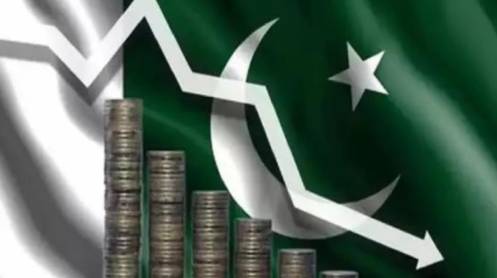ISLAMABAD: Pakistan’s total debt and liabilities have surged to nearly Rs81 trillion, marking a significant increase over the past year as the country struggles with finding new sources of financing due to poor credit ratings. According to the State Bank of Pakistan (SBP), the debt and liabilities grew by Rs8.4 trillion as of the end of March, with Rs4.4 trillion attributed to liabilities.
This immense burden now represents three-fourths of the nation’s economy and surpasses the statutory limit set by the Fiscal Responsibility and Debt Limitation Act by approximately 15% of GDP. The debt and liabilities increased at a rate of 12%, averaging Rs31 billion per day over the past year. Although the pace of debt accumulation has slowed due to a stable exchange rate and lack of major foreign funding despite the International Monetary Fund (IMF) program, the situation remains alarming.
While the rupee’s stabilization and improvement helped mitigate the increase in external debt, austerity measures by successive governments have failed to yield significant benefits. None of the three mainstream political parties have implemented meaningful reforms to curb debt growth, and the current government has continued to approve supplementary grants and subsidies, further straining the budget.
For the current fiscal year, the finance ministry initially budgeted Rs7.3 trillion for interest payments, now expected to rise to Rs8.3 trillion. Reducing debt servicing costs requires the central bank to lower key policy rates and for the government to negotiate better terms with commercial banks.
SBP data indicates that the gross public debt, directly managed by the finance ministry, reached Rs67.5 trillion by the end of March. The federal budget deficit soared to a record Rs6.7 trillion in the previous fiscal year, driven by expansionary fiscal policies.
Public Sector Enterprises’ debt and liabilities hit Rs3.8 trillion, largely borrowed to finance their deficits, with no significant government steps taken to reform state-owned enterprises. The external debt remained stable at Rs33 trillion due to the rupee’s appreciation and lack of new foreign financing.
Pakistan’s external debt and liabilities reached $130.4 billion by the end of March, a $3 billion increase over the past year. Debt owed to the IMF stood at Rs2.2 trillion, with the IMF currently assessing Pakistan’s conditions for a new bailout package.
The federal government’s total domestic debt rose to Rs43.4 trillion, an increase of Rs4.6 trillion or 12% over the past year. The country spent Rs5.8 trillion on debt servicing, a 53% increase from the previous year, with interest payments exceeding net federal income for the fiscal year.
Despite commitments to the IMF and World Bank, Pakistan’s Debt Management Office remains under-resourced, and the Ministry of Finance appears reluctant to enhance its capacity.
Story by Shahbaz Rana





